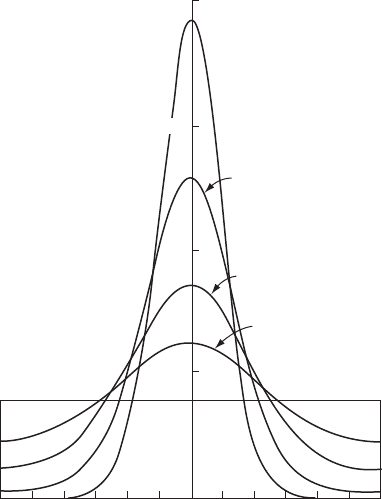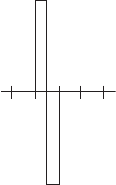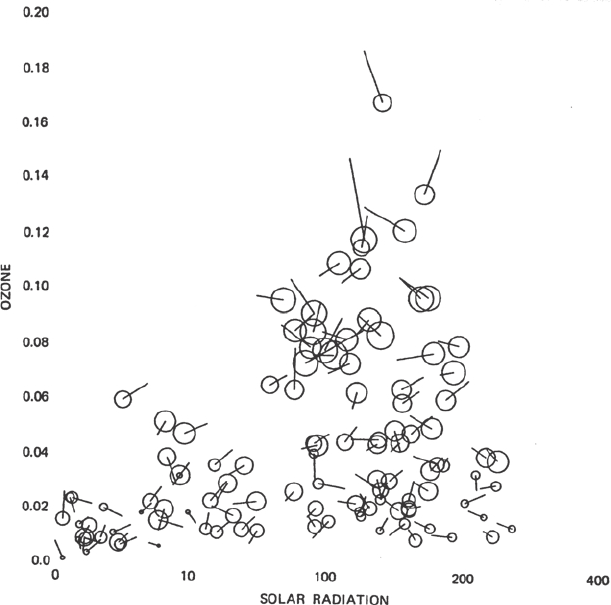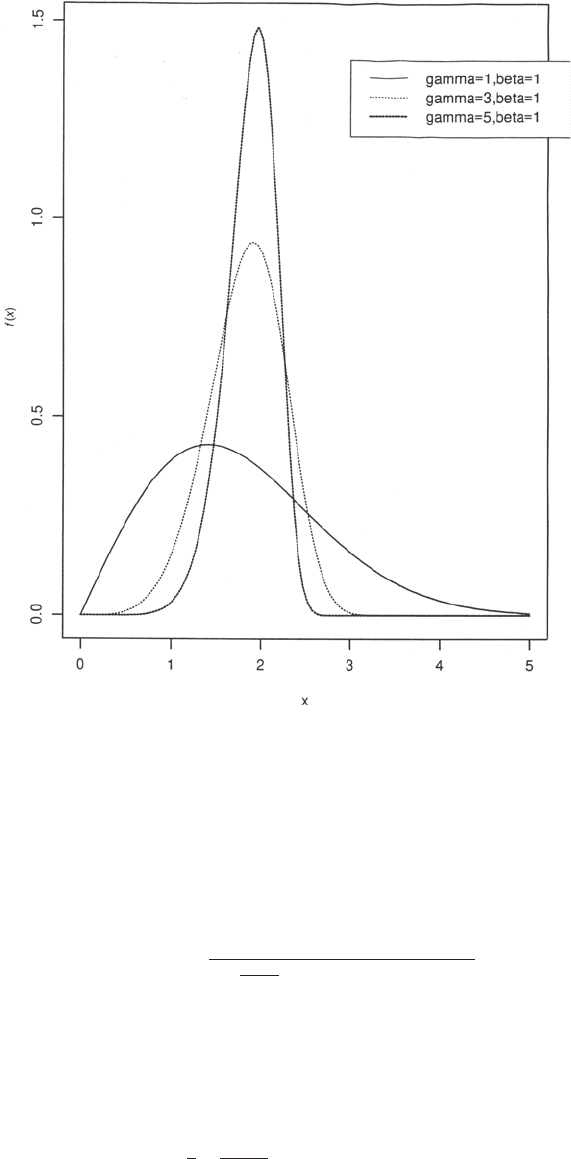Everitt B.S. The Cambridge Dictionary of Statistics
Подождите немного. Документ загружается.


stairs, or walking one block in cold weather. You have been forced to quit your job and
spend most days at home watching TV. Imagine that you are offered a possibility of an
operation that will result in complete recovery from your illness. However the operation
carries some risk. Specifically there is a probability P that you will die during the course
of the operation. How large must P be before you will decline the operation and choose
to remain in your present state?
Because few patients are accustomed to dealing in probabilities, an alternative procedure
called the time trade-off technique is often suggested, which begins by estimating the likely
remaining years of life for a healthy subject, using actuarial tables. The previous question is
rephrased as follows:
Imagine living the remainder of your natural span (an estimated number of years would
be given) in your present state. Contrast this with the alternative that you remain in
perfect health for fewer years. How many years would you sacrifice if you could have
perfect health?
[Psychiatric Services, 2000, 51, 1171–6.]
Von Neumann ratio : The ratio of the mean sequence successive difference to the sample variance
for successive observations of a
time series
, x
1
; x
2
; ...; x
n
. Suggested as a test statistic for the
independence of the observations. [Annals of Mathematical Statistics, 1941, 12, 367–95.]
Voronoi dia gram : A diagram defined for two-dimensional point patterns in which each point is
associated with the region of space that is closer to it than any other point. See also Delauney
triangulation.[Pattern Recognition, 1980, 12, 261–8.]
VPA: Abbreviation for virtual population analysis.
0.4
0.6
0.8
0.2
–
180°
–150
–120
–90
–60
–30
0
30
60
90
120
150
180°
κ = 0
κ = ½
κ = 1
κ = 2
κ = 4
Fig. 146 Some examples of Von
Mises distributions for
0
¼ 0 and
several values for κ.
449

Vuongstatistic: A statistic, V, for deciding between competing models for
count data
. The statistic is
defined as
V ¼
ffiffiffiffiffiffi
n
m
p
s
m
where m is the mean and s
m
the standard deviation of the terms, m
j
; j ¼ 1; ...; n defined as
follows
m
j
¼ 1n
^
Pr
1
ðy
j
jx
j
Þ
^
Pr
2
ðy
j
jx
j
Þ
"#
where
^
Pr
k
ðy
j
jx
j
Þ is the predicted probability of observing y
j
based on model k, and x
j
is the
vector of covariate values for the jth observation. V is asymptotically distributed as a
standard normal variable. Values greater than the chosen critical value lead to favoring the
first model and values less than the value of minus the critical value lead to favoring the
second model. Otherwise neither model is preferred. [Econometrica, 1989, 57, 307–33.]
450

W
Wagner’s hypothesis: A hypothesis advanced in the late 19th century by the German economist
Adolph Wagner that asserts that as a country’s level of development increases so does the
relative size of its public sector. [Toxicological Sciences, 2000, 58, 182–94.]
Wald, Abraham (19 02^19 5 0): Born in Cluj, Hungary (now part of Romania) Wald studied
mathematics at the University of Vienna and in 1931 received his Ph.D. degree. Emigrated
to the USA in 1938 where he studied statistics at Columbia University with
Harold Hotelling
.
Wald made important contributions to
decision theory
and in particular to
sequential
analysis
. He died on 13 December 1950 in Travancore, India as a result of a plane crash.
Wald ^Blackwell theorem: Suppose X
1
; X
2
; ... is a sequence of random variables from a distri-
bution with mean E(x) and let S be a sequential test for which E(N)isfinite. If
X
1
þ X
2
þþX
N
denotes the sum of the Xs drawn until S terminates then
E ð X
1
þþX
N
Þ¼E ð X ÞEðN Þ
[KA2 Chapter 24.]
Wald distribution: Synonym for inverse normal distribution.
Wald estimator : Consider a regression model with a single explanatory variable x which is
correlated with the error term. When a binary
instrumental variable
z exists, an
instrumental
variable estimator
for the regression parameter β is given by
β
Wald
¼
y
1
y
0
x
1
x
0
where
y
1
and
x
1
are the subsample averages of the y and x variables when z=1, and
y
0
and
x
0
are the corresponding values when z=0. [Microeconometrics, 2005, A. C. Cameron and P. K.
Trivedi, Cambridge University Press, Cambridge.]
Wald’s funda mental ident ity: A result of key importance in
sequential analysis
, which begins
with a series of mutually independent and identically distributed random variables,
Z
1
; Z
2
; ... such that PrðjZ
i
j
4
0Þ
4
0 ði ¼ 1; 2; ...Þ.IfS
n
¼ Z
1
þ Z
2
þþZ
n
, and N is
the first value of n such that the inequalities b
5
S
n
5
a are violated then
E ½e
tS
n
fMðtÞg
N
¼1
where M(t) is the common
moment generating function
of the Zs. [KA2 Chapter 24.]
Wald’s test: Typically (but not necessarily) a test for the hypothesis that a vector of parameters,
q
0
¼½
1
;
2
; ...;
m
, is the null vector. The test statistic is
W ¼
^
q
0
V
1
^
q
where
^
q
0
contains the estimated parameter values and V is the asymptotic variance–
covariance matrix of
^
q. Under the hypothesis, W has an asymptotic
chi-squared distribution
451

with degrees of freedom equal to the number of parameters. In contrast to the
likelihood ratio
test
, for which Wald’s test is a quadratic approximation, the wald test only requires
estimation under the alternative hypothesis. See also likelihood ratio test and score test.
[KA2 Chapter 25.]
Wald^Wolfowitz test: A
distribution free method
for testing the null hypothesis that two samples
come from identical populations. The test is based on a count of number of
runs
. [KA2
Chapter 30.]
Walker’s test: A test for non-zero periodic ordinates in a
periodogram
. The test statistic is
γ ¼ max
1p½N=2
Iðω
p
Þ=
2
x
where N is the length of the series,
2
x
is the variance of the series and IðωÞ represents the
periodogram. Under the hypothesis that the ordinate is zero, γ is the maximum of [n/2]
independent exponential variables. [Applications of Time Series Analysis in Astronomy and
Meteorology, 1997, edited by T. Subba Rao, M. B. Priestley and O. Lessi, Chapman and
Hall/CRC Press, London.]
Walsh averages : For a random variable [x
1
; x
2
; ...; x
n
] from a symmetric distribution the
nðn þ 1Þ=2 pairwise averages of the form ðx
i
þ x
j
Þ=2 computed for all i and j from 1 to n.
The basis for the
Hodges–Lehmann estimator
and also used in the construction of a
confidence interval
for the median. [Encyclopedia of Statistical Sciences, 2006, eds.
S. Kotz, C. B. Read, N. Balakrishnan and B. Vidakovic, Wiley, New York.]
Ward’s method: An
agglomerative hierarchical clustering method
in which a sum-of-squares
criterion is used to decide on which individuals or which clusters should be fused at each
stage in the procedure. See also single linkage, average linkage, complete linkage and
K-means cluster analysis. [MV2 Chapter 10.]
Wa ring d ist ri but i on: A distribution for x ¼ 0; 1; 2 ...given as
pðx; c; aÞ¼
ðc aÞða þ x 1Þ!c!
cða 1Þ!ðc þ xÞ
where c
4
0 and a
4
0 are shape parameters with c
4
a. The
Yule distribution
is the
special case when a ¼ 1. [Journal of the Royal Statistical Society, Series A, 1963, 126,
1–44.]
Waring’stheorem: A theorem giving the probability of occurence of events A
1
; A
2
; ...; A
n
that are
not
mutually exclusive
. The theorem states that
PrðA
1
[ A
2
[[A
n
Þ¼
X
n
i¼1
PrðA
i
Þ
X
n1
i
1
X
n
5
i
2
PrðA
i
1
\ A
i
2
Þ
þ
X
n2
i
1
X
n1
5
i
2
X
n
5
i
3
PrðA
i
1
\ A
i
2
\ A
i
3
Þ
þð1Þ
nþ1
Prð\
n
i¼1
A
i
Þ
For example, for two events A
1
and A
2
PrðA
1
[ A
2
Þ¼PrðA
1
ÞþPrðA
2
ÞPrðA
1
\ A
2
Þ
See also addition rule. [KA1 Chapter 8.]
Warning lines: Lines on a
quality control chart
indicating a mild degree of departure from a desired
level of control.
Warping functions: See curve registration.
452

Wash- out model: see compartment models.
Wash-outperiod: An interval introduced between the treatment periods in a
crossover design
in an
effort to eliminate possible
carryover effects
. [SMR Chapter 15.]
Wassersteinmetrics: Measures of the discrepancy between two cumulative distribution functions
given by
Z
1
0
jF
1
1
ðuÞF
1
2
ðuÞj
p
du
1
p
where F
1
i
ðuÞ¼minft : F
j
ðt Þug; j ¼ 1; 2. Most often used to compare two survival
functions. When p ¼ 1 the distance measure between two estimated survival curves is the
shaded area in Fig. 147.[Recursive Partitioning in the Health Sciences, 1999, H. Zhang and
B. Singer, Springer, New York.]
Watson, Geoffrey Stuart (1921^1998): Watson was born in Bendigo, Australia. He was
educated at Bendigo High School and Scotch College, Melbourne and later read mathe-
matics at the University of Melbourne, graduating in 1942. After two years at the Institute of
Statistics in North Carolina, he returned to Australia and became Senior Fellow at the
Australian National University. In 1962 he became professor of statistics at the Johns
Hopkins University and in 1970 Chairman of Statistics at Princeton University from
where he retired in 1991. Watson made wide range of contributions to statistics including
to
times series
,
directional data analysis
and
least squares estimation
. He died on 3 January
1998.
Watson’s A-test: A test of the uniformity of a
circular distribution
.[Biometrika, 1967, 54, 675–7.]
Watson’s te st: A test that a
circular random variable
θ has an
angular uniform distribution
. Given a
set of observed values
1
;
2
; ...;
n
the test statistic is
U
2
¼
X
n
j¼1
½x
j
ð2j 1Þ=ð2nÞ
2
n
x
1
2
þ 1=ð12nÞ
where x
j
¼
j
=2p. This statistic has an approximate standard normal distribution under the
hypothesis of an angular uniform distribution. See also Kuiper’s test. [MV2 Chapter 14.]
W avelet analysis: An approach to representing signals that is analogous to the
Fourier series
approximation but which uses a linear combination of
wavelet functions
rather than
trignometric sine and cosine functions. The strength of such methods lie in their ability to
A Kaplan – Meier curve of a pure node
1
0
time
A generic Kaplan – Meier curve
The distance (or area)
between the two curves
Fig. 147 Wasserstein
metrics.
453

describe local phenomena more accurately than can a traditional expansion in sines and
cosines. Thus wavelets are ideal in many fields where an approach to transient behaviour is
needed, for example, in considering acoustic or seismic signals, or in image processing.
As with a sine or cosine wave, wavelet functions oscillate about zero, but the oscillations
damp down to zero so that the function is localized in time or space. Such functions can be
classified into two types, usually referred to as
mother wavelets
(ψ) and father wavelets ().
The former integrates to 0 and the latter to 1. Roughly speaking, the father wavelets are good
at representing the smooth and low frequency parts of a signal and the mother wavelets are
good at representing the detail and high frequency parts of a signal.
The orthogonal
wavelet series approximation
to a continuous time signal f (t) is given by
f ðtÞ
X
k
s
J ;k
J ;k
ðt Þþ
X
k
d
J ;k
ψ
J ;k
ðt Þþ
X
k
d
J 1;k
ψ
J 1;k
ðt Þþþ
X
k
d
1;k
ψ
1;k
ðt Þ
where J is the number of multiresolution components and k ranges from 1 to the number of
coefficients in the specified component. The first term provides a smooth approximation of f
(t) at scale J by the so-called scaling function,
J ;k
ðt Þ . The remaining terms represent the
wavelet decomposition proper and ψ
j;k
ðtÞ; j ¼ 1; ...; J are the approximating wavelet
functions; these are obtained through translation, k, and dilation, j, of a prototype wavelet
ψðtÞ (an example is the
Haar wavelet
shown in Fig. 148) as follows
ψ
j;k
ðt Þ¼2
j=2
ψð2
j
t kÞ
The wavelet coefficients s
J ;k
; d
J ;k
; ...; d
1;k
are given approximately by the integrals
s
J ;k
Z
J ;k
f ðtÞdt
d
J ;k
Z
ψ
j;k
ðtÞf ðtÞdtj¼ 1; 2; ...; J
Their magnitude gives a measure of the contribution of the corresponding wavelet function
to the approximating sum. Such a representation is particularly useful for signals with
features that change over time and signals that have jumps or other non-smooth features
for which traditional Fourier series approximations are not well suited. See also discrete
wavelet transform.[Applications of Time Series Analysis in Astronomy and Meteorology,
1997, edited by T. Subba Rao, M. B. Priestley and O. Lessi, Chapman and Hall/CRC Press,
London.]
Wavelet functions: See wavelet analysis.
W avelet series approximation: See wavelet analysis.
Wave let transf orm coeff ici ents: See wavelet analysis.
WaveShrink : An approach to function estimation and
nonparametric regression
which is based on the
principle of shrinking
wavelet transform coefficients
toward zero to remove noise. The
0
1
1
–1
2
Ψ
H
(l)
x
Fig. 148 The Haar wavelet.
454

procedure has very broad asymptotic near-optimality properties. [Biometrika, 1996, 83,
727–45.]
Weakest-link model: A model for the strength of brittle material that assumes that this will be
determined by the weakest element of the material, all elements acting independently and all
equally likely to be the cause of failure under a specified load. This enables the strength of
different lengths of material to be predicted, provided that the strength of one length is
known. Explicitly the model is given by
S
l
ðxÞ¼fS
1
ðxÞg
l
where S
l
(x) is the probability distribution that a fibre of length l survives stress x, with S
1
(x)
being a
Weibull distribution
.[Scandinavian Journal of Metallurgy, 1994, 23,42–6.]
Weather vane plot : A graphical display of multivariate data based on the
bubble plot
. The latter is
enhanced by the addiction of lines whose lengths and directions code the values of additional
variables. Figure 149 shows an example of such a plot on some air pollution data. [Methods
for the Statistical Analysis of Multivariate Observations, 2nd edition, 1997,
R. Gnanadesikan, Wiley, New York.]
Wedderburn, Robert William Maclagan (1947^1975): Born in Edinburgh, Wedderburn
attended Fettes College and then studied mathematics and statistics at Cambridge. He then
joined the Statistics Department at Rothamsted Experimental Station. During his tragically
curtailed career Wedderburn made a major contribution to work on
generalized linear
models
, developing the notion of
quasi-likelihood
. He died in June 1975.
W eibull distribution: The probability distribution, f(x), given by
f ðxÞ¼
γx
γ1
β
γ
exp
x
β
γ
0 x
5
1 β
4
0 γ
4
0
Examples of the distribution are given in Fig. 150. The mean and variance of the distribution
are as follows
mean ¼ βG½ðγ þ 1Þ=γ
variance ¼ β
2
ðG½ðγ þ2Þ=γfG½ðγ þ1Þ=γg
2
Þ
The distribution occurs in the analysis of
survival data
and has the important property that
the corresponding
hazard function
can be made to increase with time, decrease with time, or
remain constant, by a suitable choice of parameter values. When γ = 1 the distribution
reduces to the
exponential distribution
. [STD Chapter 41.]
W eig htedaverage: An average of quantities to which have been attached a series of weights in order
to make proper allowance for their relative importance. For example a weighted arithmetic
mean of a set of observations, x
1
; x
2
; ...; x
n
, with weights w
1
; w
2
; ...; w
n
, is given by
P
n
i¼1
w
i
x
i
P
n
i¼1
w
i
W eighted binomial distribution: A probability distribution of the form
f
wðxÞ
ðxÞ¼
wðxÞB
n
ðx; pÞ
P
n
x¼0
wðxÞB
n
ðx; pÞ
where wðxÞ
4
0ðx ¼ 1; 2; ...; nÞ is a positive weight function and B
n
ðx; pÞ is the
binomial?
distribution
. Such a distribution has been used in a variety of situations including describing
455

the distribution of the number of albino children in a family of size n.[Biometrics, 1990, 46,
645–56.]
Weighted generalized estimating equations (WGEE): See generalized estimating
equations.
Weighted kappa: A version of the
kappa coefficient
that permits disagreements between raters
to be differentially weighted to allow for differences in how serious such disagreements
are judged to be. [Statistical Evaluation of Measurement Errors, 2004, G. Dunn, Arnold,
London.]
W eighted least squares: A method of estimation in which estimates arise from minimizing a
weighted sum of squares of the differences between the response variable and its predicted
value in terms of the model of interest. Often used when the variance of the response variable
is thought to change over the range of values of the explanatory variable(s), in which case the
weights are generally taken as the reciprocals of the variance. See also heteroscedasticity,
least squares estimation and iteratively weighted least squares. [ARA Chapter 11.]
Wei g ht of evi dence ( WE ) : A term used in the context of the use of nuclear deoxyribonucleic
(DNA) for identification purposes. The joint probability of observing the genotypes that
constitute evidence is quantified in turn by conditioning on pairs of hypotheses which are of
forensic interest. The ratio of the two probabilities is the WE. [Journal of the Royal
Statistical Society, Series A, 2003, 166, 425–440.]
Fig. 149 Weathervane plot.
456

Wei^Lachintest: A
distribution free method
for the equality of two multivariate distributions. Most
often used in the analysis of
longitudinal data
with missing observations. [Journal of the
American Statistical Association, 1984, 79, 653–61.]
Welch’s statistic: A test statistic for use in testing the equality of a set of means in a
one-way design
where it cannot be assumed that the population variances are equal. The statistic is defined as
W ¼
P
g
i¼1
w
i
½ð
x
i
~
xÞ
2
=ðg 1Þ
1 þ
2ðg2Þ
g
2
1
P
g
i¼1
½ð1 w
i
=uÞ
2
ðn
i
1Þ
where g is the number of groups,
x
i
; i ¼ 1; 2; ...; g are the group means, w
i
¼ n
i
=s
2
i
with n
i
being the number of observations in the ith group and s
2
i
being the variance of the ith group,
u ¼
P
g
i¼1
w
i
and
~
x ¼
P
g
i¼1
w
i
x
i
=u. When all the population means are equal (even if the
variances are unequal), W has, approximately, an
F-distribution
with g – 1 and f degrees of
freedom, where f is defined by
1
f
¼
3
g
2
1
X
g
i¼1
½ð1 w
i
=uÞ
2
=ðn
1
1Þ
Fig. 150 Examples of Weibull distributions for several values of γ at β=2.
457

When there are only two groups this approach reduces to the test discussed under the entry
for
Behrens–Fisher problem
.[Biometrika, 1951, 38, 330–6.]
Westergaard, Harald (1853^1936): After training as a mathematician, Westergaard went on to
study political economy and statistics. In 1883 he joined the University of Copenhagen as a
lecturer in political science and the theory of statistics, the first to teach the latter subject at
the university. Through his textbooks Westergaard exerted a strong influence on Danish
statistics and social research for many years. After his retirement in 1924 he published
Contributions to the History of Statistics
in 1932 showing how much statistical knowledge
has increased, from its small beginnings in the 17th century to its considerable scope at the
end of the 19th century.
WE-test: A test of whether a set of
survival times
t
1
; t
2
; ...; t
n
are from an
exponential distribution
.
The test statistic is
WE ¼
P
n
i¼1
ðt
i
t Þ
2
ð
P
n
i¼1
t
i
Þ
2
where
t is the sample mean.
Critical values
of the test statistic have been tabulated.
Wherry’sformula: See shrinkage formulae.
Whi pple i ndex: An index used to investigate the possibility of
age heaping
in the reporting of ages in
surveys. The index is obtained by summing the age returns between 23 and 62 years
inclusive and finding what percentage is borne by the sum of the returns ending with 5
and 0 to one-fifth of the total sum. The results will vary between a minimum of 100,
consistent with no age heaping, and a maximum of 500, if no returns were recorded with
any digits other than 0 or 5. [Demography, 1985, W. P. Mostert, B. E. Hofmeyer, J. S.
Oostenhuizen, J. A. van Zyl, Human Sciences Research Council, Pretoria.]
White noise: Term often used in
time series
to refer to an error term that has expectation zero and
constant variance at all time-points and is uncorrelated over time.
Wh ite’s i nformationmatrix test: A specification test for parametric models which are estimated
by maximum
likelihood
. Based on the fact that the Hessian and outer-product of the
gradients forms of the
information matrix
are equal if the model is correctly specified.
Under the null hypothesis of correct specification the test statistic has an asymptotic χ
2
distribution. However, simulations have shown that the null distribution can be very
different from χ
2
in small samples. [Econometrica, 1982, 50,1–26.]
Wh ite’shomoscedasticity test: A test that assesses whether the error term in a linear regression
model has a constant variance. [Econometrica, 1980, 48, 817–838.]
Whittl e l ik e lihood: An approximate
likelihood function
used to estimate the
spectral density
and
certain parameters of a variety of time series models. [Communication in Statistics:
Simulation and Computation, 2006, 35, 857–875.]
WG EE: Abbreviation for weighted generalized estimating equations.
Wichman/Hill generator: A
random number generator
with good randomness properties.
[Applied Statistics, 1982, 31, 188–90.]
Wiener, Norbert(1894^1964): Wiener was a child prodigy who entered Tufts College at the age
of 11, graduating three years later. He began his graduate studies at Harvard aged 14, and
458
